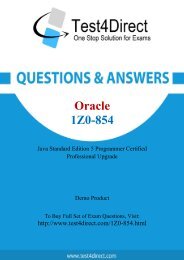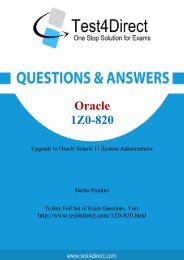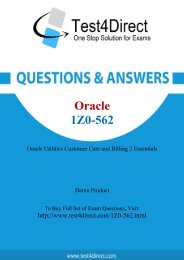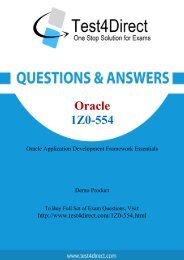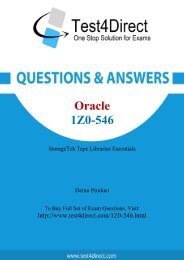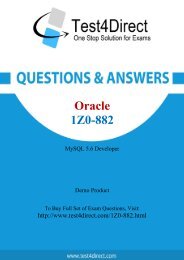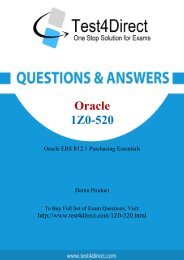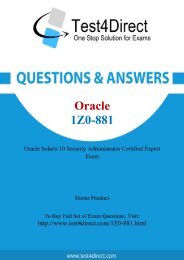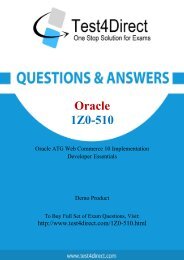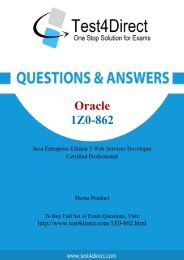Buy 1Z0-517 BrainDumps and Get Discount
Test4Direct provides latest PDF questions of Oracle 1Z0-517 exam. You have an opportunity to pass the Oracle 1Z0-517 exam in one go. Test4Direct is most accurate source to prepare Oracle 1Z0-517 exam as your success will become site’s responsibility after purchasing 1Z0-517 exam product. There are also lots of discounts and promotion offers that you can avail. Let’s try a free demo http://www.test4direct.com/1Z0-517.html
Test4Direct provides latest PDF questions of Oracle 1Z0-517 exam. You have an opportunity to pass the Oracle 1Z0-517 exam in one go. Test4Direct is most accurate source to prepare Oracle 1Z0-517 exam as your success will become site’s responsibility after purchasing 1Z0-517 exam product. There are also lots of discounts and promotion offers that you can avail. Let’s try a free demo http://www.test4direct.com/1Z0-517.html
You also want an ePaper? Increase the reach of your titles
YUMPU automatically turns print PDFs into web optimized ePapers that Google loves.
Oracle<br />
<strong>1Z0</strong>-<strong>517</strong><br />
Oracle E-Business Suite 12: Oracle Payables Essentials<br />
Demo Product<br />
To <strong>Buy</strong> Full Set of Exam Questions, Visit:<br />
http://www.test4direct.com/<strong>1Z0</strong>-<strong>517</strong>.html
Question: 1<br />
What is a benefit of the secondary tracking segment?<br />
A. Additional security ensures that correct accounts are selected while entering transactions.<br />
B. The Management segment is enabled automatically when the secondary segment is defined.<br />
C. More details are provided to retained earnings, cumulative translation adjustments, <strong>and</strong><br />
revaluation gains/losses accounts.<br />
Question: 2<br />
Question: 3<br />
Question: 4<br />
Answer: C<br />
Isa Global Inc. is based in the United States with divisions in Europe <strong>and</strong> Asia. All journal imports,<br />
recurring journals, mass allocations, <strong>and</strong> manual journal entries have been posted for their European<br />
subsidiary. What is the next logical step in the period-close process?<br />
A. opening the next period<br />
B. closing the current period<br />
C. revaluing foreign currency balances<br />
D. translating to the functional currency<br />
E. consolidating to the parent set of books<br />
Select two actions that ledger sets permit. (Choose two.)<br />
A. performing variance inquiries<br />
B. being used for mass budgets<br />
C. sending budget balance inquiries<br />
D. viewing account balances for multiple ledgers in one view<br />
E. grouping multiple ledgers that share the same chart of accounts <strong>and</strong> calendar<br />
Answer: C<br />
Answer: D,E<br />
Select three activities that must be performed to complete the setup of the key accounting flexfield.<br />
(Choose three.)<br />
A. Create aliases.<br />
B. Define a value set.<br />
C. Define security rules.
D. Define an account structure.<br />
E. Define valid segment values.<br />
F. Create account combinations.<br />
Answer: B,D,E<br />
Question: 5<br />
Which two statements are true about the reporting currency in Oracle General Ledger? (Choose<br />
two.)<br />
A. It is an integrated extension of a ledger.<br />
B. It replaces multiple reporting currencies.<br />
C. Reporting currencies are the same as secondary ledgers.<br />
D. Reporting currencies cannot have the same chart of accounts, accounting method, <strong>and</strong> ledger<br />
processing options.<br />
Question: 6<br />
Which three activities would use summary accounts? (Choose three.)<br />
Question: 7<br />
Question: 8<br />
Answer: A,B<br />
A. creating a monthly recurring st<strong>and</strong>ard journal entry to amortize goodwill<br />
B. allocating the total monthly costs of the Information Services department to other departments<br />
C. estimating a sales commission accrual based on the total of all product sales for each division<br />
D. formulating a budget for employee benefits in each company based on the total of all budgeted<br />
employee salaries<br />
Answer: B,C,D<br />
The company two senior executives have different budget figures. They want Peter, the GL<br />
accountant, to prepare two current budgets in Oracle Financials <strong>and</strong> submit budgets to both of them.<br />
What would be your response?<br />
A. It is not possible to have more than one current budget.<br />
B. Whether you can have multiple current budgets depends on the budget organization.<br />
C. The Require Budget Journal profile option must be set at the budget level if you want to have<br />
multiple current budgets.<br />
D. The Require Budget Journal profile option must be set at the set of books level if you want to have<br />
multiple current budgets.<br />
E. The Oracle General Ledger budget functionality supports multiple current budgets, so there is no<br />
problem in satisfying this requirement.<br />
Answer: A
Identify the four setup options that control supplier defaults. (Choose four.)<br />
A. financial options<br />
B. payables options<br />
C. receiving options<br />
D. purchasing options<br />
E. Payables system setup<br />
F. Trading Community Architecture (TCA)<br />
Answer: A,B,D,E<br />
Question: 9<br />
Identify three ways that an invoice can be submitted for validation. (Choose three.)<br />
A. online by clicking the Validate button in the Invoice Batches window<br />
B. online by clicking the Validate <strong>and</strong> Account button in the Invoice Batches window<br />
C. in batch by submitting the Payables Invoice Validation program from the Invoice Workbench<br />
D. in batch by submitting the Payables Invoice Validation program from the Submit Request window<br />
E. online by selecting either the Validate check box or the Validate Related Invoices check box in the<br />
Invoice Actions window<br />
Question: 10<br />
Question: 11<br />
Answer: A,D,E<br />
You are working on an implementation for Accounts Payable for ABC Inc. Your client has three<br />
requirements:<br />
1. They want to be able to pay only certain types of suppliers by batch.<br />
2. Each payment batch must be under $100,000 USD, or the batch automatically gets canceled<br />
without user intervention.<br />
3. Each single payment for a supplier site must be between $10 USD <strong>and</strong> $10,000 USD, or the<br />
payment is automatically not issued.<br />
To meet the above requirements, you perform these steps:<br />
a) Set up suppliers with pay groups for each type, <strong>and</strong> use them when running the payment batch.<br />
b) Set up the payment batch with Maximum Outlay equal to $100,000 USD.<br />
c) Set up the payment batch with Maximum/Minimum payments as $10 USD <strong>and</strong> $10,000 USD.<br />
Which requirements have you met?<br />
A. 2 <strong>and</strong> 3<br />
B. 1, 2 <strong>and</strong> 3<br />
C. 1 <strong>and</strong> 2<br />
D. 1 <strong>and</strong> 3<br />
Answer: D
Pay able lists four seeded payment methods. They are check, outsourced check, electronic, <strong>and</strong> wire.<br />
Choose the correct description for wire.<br />
A. a paper check to print <strong>and</strong> send to a supplier<br />
B. an EFT, EDI, or XML to the bank of a supplier<br />
C. a funds transfer initiated by contacting the bank <strong>and</strong> requesting wire payment to the bank of a<br />
supplier<br />
D. transmission of payment information to an external party, such as your bank, that prints checks on<br />
your behalf<br />
Question: 12<br />
Question: 13<br />
Question: 14<br />
Answer: C<br />
With Oracle Cash Management, you can reconcile payments created in Payables to your bank<br />
statements. When you reconcile payments using Oracle Cash Management, Cash Management<br />
updates the status of payments. Select the new status.<br />
A. issued<br />
B. updated<br />
C. negotiable<br />
D. reconciled<br />
Which event reverses an accrual for an item set to accrue on receipt?<br />
A. paying an invoice<br />
B. delivering goods to a final destination<br />
C. running the Receipt Accruals - Period-end process<br />
D. matching an invoice in Payables to a purchase order<br />
Question: 15<br />
Answer: D<br />
Answer: D<br />
Identify three setup options that are defined in the Financial Options window. (Choose three.)<br />
A. interest<br />
B. retainage<br />
C. miscellaneous<br />
D. expenses clearing<br />
E. expense AP accrual account<br />
Answer: B,C,D
Select two actions available in Oracle General Ledger. (Choose two.)<br />
A. deleting posted journals<br />
B. exporting data to subsidiary ledgers<br />
C. importing data from subsidiary ledgers<br />
D. consolidating balances in subsidiary ledgers<br />
E. consolidating balances from multiple ledgers<br />
Answer: C,E<br />
Question: 16<br />
Which module of Oracle E-Business Suite Release 12 sends revaluation <strong>and</strong> accrual entries to General<br />
Ledger?<br />
A. Oracle Assets<br />
B. Oracle Projects<br />
C. Oracle Treasury<br />
D. Oracle Receivables<br />
E. Oracle Property Manager<br />
Question: 17<br />
Question: 18<br />
Answer: C<br />
Identify the different types of data that can be processed using the GL Interface. (Choose three.)<br />
A. rates<br />
B. budget<br />
C. vendors<br />
D. statistical<br />
E. intercompany<br />
F. currency codes<br />
Answer: B,D,E<br />
Choose the reason why Tina is unable to view the subledger entries from Oracle Payables in the<br />
Oracle General Ledger module. She has run the transfer program that completes successfully.<br />
A. Journal Import is not submitted.<br />
B. The Journal source is not defined.<br />
C. The Journal category is not defined.<br />
D. Payables is not integrated with General Ledger.<br />
Answer: A
Question: 19<br />
ABC Corporation has five companies, which operate in different industries. Each company has a<br />
different ledger-processing option that is industry specific. Choose the number of primary ledgers<br />
that are required to be defined.<br />
A. five<br />
B. four<br />
C. two<br />
D. one<br />
E. three<br />
Question: 20<br />
Question: 21<br />
Question: 22<br />
Answer: A<br />
Choose three tables that will be populated when the Journal Import process is run with the option to<br />
post set as "Yes." (Choose three.)<br />
A. GL_JE_LINES<br />
B. GL_JE_BATCHES<br />
C. GL_JE_HEADERS<br />
D. GL_JE_SOURCES<br />
E. GL_IMPORT_REFERENCES<br />
Answer: A,B,C<br />
Select three levels where additional reporting currency representations can be maintained. (Choose<br />
three.)<br />
A. batch<br />
B. journal<br />
C. balance<br />
D. subledger<br />
Answer: B,C,D<br />
You are implementing Oracle General Ledger at a client site. The client is based in the US, but they<br />
have a global presence in many countries <strong>and</strong> transactions in multiple currencies. The<br />
implementation team decides that the Oracle General Ledger multi-currency setup will be a part of<br />
the implementation. The client's Chief Financial Officer wants a system that has these features:<br />
1. Enter transactions <strong>and</strong> reports in any currency.<br />
2. Enter exchange rates online or automatically.<br />
3. Calculate realized <strong>and</strong> unrealized gains <strong>and</strong> losses. IV. Translate actual <strong>and</strong> budget balances.<br />
4. Produce foreign currency financial statements <strong>and</strong> reports. Which requirements can be satisfied
with the implementation?<br />
A. 1, 2, <strong>and</strong> 3 only<br />
B. 1, 2, 3, <strong>and</strong> 4 only<br />
C. 1, 2, 4, <strong>and</strong> 5 only<br />
D. All requirements from 1 through 5 can be satisfied.<br />
Answer: D<br />
Question: 23<br />
Identify three statements that are correct for the multi-currency functionality of Oracle General<br />
Ledger. (Choose three.)<br />
A. Enter transactions <strong>and</strong> reports in any currency.<br />
B. Enter exchange rates online <strong>and</strong> automatically.<br />
C. Translate only actual but not budgeted balances.<br />
D. Translate only budgeted but not actual balances.<br />
E. Use daily, period end, average, <strong>and</strong> historical rates.<br />
Question: 24<br />
Question: 25<br />
Answer: A,B,E<br />
Which three are the benefits of the Currency Rates Manager in Oracle General Ledger? (Choose<br />
three.)<br />
A. You can maintain daily rates <strong>and</strong> historical rates more easily.<br />
B. You get improved efficiency with the help of the spreadsheet interface.<br />
C. You can maintain consistency among different currency conversion rates.<br />
D. Additional security ensures that historical rates can be uploaded to closed or future periods only.<br />
E. You can maximize intercompany imbalances during intercompany eliminations of foreign currency<br />
transactions that are due to exchange rate differences.<br />
Answer: A,B,C<br />
John, the rates manager at ABC Company in the USA, is in charge of maintaining currency rates for<br />
the entire company. John had defined the rates for GBP to USD <strong>and</strong> GBP to Indian Rupee (INR) only.<br />
Sam, the company accountant, is worried that he would not be able to execute transactions involving<br />
USD <strong>and</strong> INR currencies. What does John say to help Sam?<br />
A. Currency Rates Manager automatically converts all transactions entered in INR to USD.<br />
B. Currency Rates Manager automatically converts all transactions entered in INR to GBP first <strong>and</strong><br />
then to USD.<br />
C. Currency Rates Manager automatically performs the calculation between USD <strong>and</strong> INR on the<br />
basis of cross-rate rules.<br />
D. Sam must manually define the USD to INR rates first, to be able to enter transactions involving
USD <strong>and</strong> INR currency.<br />
E. Sam must manually define the INR to USD rates first, to be able to enter transactions involving<br />
USD <strong>and</strong> INR currency.<br />
Question: 26<br />
Question: 27<br />
Answer: C<br />
You are implementing Oracle General Ledger (GL) at a client site. The client is based in the US, but<br />
they have a presence in many countries <strong>and</strong> transactions in multiple currencies. The implementation<br />
team decides that the GL multi-currency setup will be a part of the implementation. John, a junior<br />
consultant helping you in the implementation effort, tells you that he is testing the system <strong>and</strong><br />
entering journals in USD, Yen, <strong>and</strong> Euros. He says that he is able to enter journals in USD <strong>and</strong> Euros,<br />
but not in Japanese Yen. What possible explanation can you provide to John for this?<br />
A. Yen has not been enabled.<br />
B. Rate types have not been defined for Yen.<br />
C. Daily rates have not been entered for Yen.<br />
D. Workflow must be customized for journals to be entered in Yen.<br />
Question: 28<br />
Answer: A<br />
Scott, the CFO at ABC Company in the USA, wants to present the annual income statement to the<br />
board of directors of the company. ABC Company engages in many exports <strong>and</strong> import activities <strong>and</strong><br />
follows the policy to revalue all its transactions in foreign currency with the current market rates.<br />
Scott requests George, the head accountant of the company, to revalue all foreign currency<br />
transactions done during the year. Select two prerequisites that George must comply with to ensure<br />
that the revaluation is done as desired. (Choose two.)<br />
A. Define accounts for realized gains <strong>and</strong> realized losses.<br />
B. Define accounts for unrealized gains <strong>and</strong> unrealized losses.<br />
C. Define the weights for each currency used for doing transactions.<br />
D. Define a batch under which the revaluation journals would be stored.<br />
E. Define a revaluation rate for each currency for each period or date for which the revaluation must<br />
be run.<br />
Answer: B,E<br />
You are implementing Oracle General Ledger at a client site. The client is based in the US, but they<br />
have a presence in many countries <strong>and</strong> transactions in multiple currencies. The implementation team<br />
decides that the GL multi-currency setup will be a part of the implementation. The company's<br />
management in the US wants to see all transactions in USD, whereas the management in Europe<br />
wants to see the transactions in Euros. The CFO has this requirement:<br />
While entering daily transactions, the user must be able to enter the current exchange rate. But at<br />
month end, the assets <strong>and</strong> liabilities in Euros must be converted into USD at the monthly average
exchange rate. Can this requirement be satisfied?<br />
A. Oracle GL does not support this functionality.<br />
B. Workflow must be customized to satisfy this requirement.<br />
C. The account generator must be customized to satisfy this requirement.<br />
D. Oracle GL provides this functionality <strong>and</strong> there is no problem in satisfying the requirement.<br />
Question: 29<br />
Question: 30<br />
Answer: D<br />
ABC Company in India imports baking equipment from XYZ Company in the USA. There is an<br />
outst<strong>and</strong>ing invoice of $1,000,000 to be paid in two months. The USD-to-INR rate when the<br />
transaction was done was 47.5. Now the USD-to-INR rate has changed from 47.5 to 40.5. Jack, who is<br />
a treasury analyst at ABC Company, reviews the transactions <strong>and</strong> comes to a conclusion. Select two<br />
correct conclusions arrived upon by Jack. (Choose two.)<br />
A. XYZ Company is not impacted at all by this rate change.<br />
B. XYZ Company has a positive impact by this rate change.<br />
C. ABC Company is not impacted at all by this rate change.<br />
D. ABC Company has a positive impact by this rate change.<br />
Answer: A,D<br />
Select two statements that are correct for the secondary tracking segment. (Choose two.)<br />
A. Only the natural account segment or the balancing segment can be specified as the secondary<br />
tracking segment.<br />
B. Any segment that is specified as the secondary tracking segment also must be specified as the<br />
management segment.<br />
C. Any segment, except the natural account segment or the balancing segment, can be specified as<br />
the secondary tracking segment.<br />
D. This segment will be paired with the balancing segment when generating account balances for<br />
retained earnings account, unrealized gains or losses account, <strong>and</strong> the cumulative translation<br />
adjustment account.<br />
E. This segment will be paired with the natural account segment when generating account balances<br />
for retained earnings account, unrealized gains or losses account, <strong>and</strong> the cumulative translation<br />
adjustment account.<br />
Answer: C,D
THANKS FOR TRYING THE DEMO OF OUR PRODUCT<br />
Visit Our Site to Purchase the Full Set of Actual <strong>1Z0</strong>-<strong>517</strong> Exam Questions With Answers.<br />
http://www.test4direct.com/<strong>1Z0</strong>-<strong>517</strong>.html<br />
We Also Provide Practice Exam Software That Simulates Real Exam Environment And Has<br />
Many Self-Assessment Features. Download Free Product Demo From:<br />
http://www.test4direct.com/<strong>1Z0</strong>-<strong>517</strong>.html<br />
Money Back Guarantee<br />
Check Out Our Customer Testimonials






